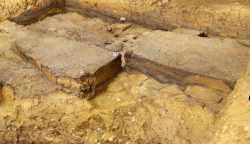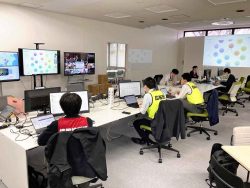12:29 JST, December 13, 2022
Roads, bridges and other infrastructure in Japan are rapidly aging and deteriorating. To ensure safe use over a long period, it is important to begin repairs before their deterioration becomes serious.
Ten years have passed since the accident at the Sasago Tunnel on the Chuo Expressway in Yamanashi Prefecture, in which nine people died when aging ceiling slabs collapsed. Following that incident, revisions to the Road Law made it mandatory for the central and local governments to inspect bridges and tunnels on roads once every five years.
In tandem with these changes, a system was introduced to categorize the need for repairs into four levels, including “early” and “urgent,” depending on the degree of deterioration. Despite these rankings, however, repair work has not progressed sufficiently, and the risk of accidents has not been reduced.
In particular, road bridges are numerous and urgently need to be dealt with. Of about 700,000 road bridges nationwide, more than 50,000 are said to be in need of early or urgent repairs. In particular, municipalities are said to be notoriously slow to deal with the bridges they manage.
The village of Totsukawa in Nara Prefecture has closed seven bridges to traffic because of the lack of progress in repairing them, even though the village government classified those bridges as needing urgent repairs. There are also 25 other bridges that need early repairs. However, only a few specialist officials can order repairs, and the village government is said to be unable to cope with the situation.
Many municipalities are also unable to proceed with repair work as planned due to limited budgets.
Repairs must be prioritized and implemented efficiently. The introduction of a system in which multiple municipalities jointly manage bridges and tunnels to make up for budget and staff shortages should also be considered. Coordination by the central and prefectural governments is essential for this purpose.
Aging infrastructure will continue to deteriorate. More than 30% of the bridges in Japan were built at least 50 years ago, and this figure will reach 60% in 10 years. The maintenance and inspection of bridges as well as tunnels is increasingly important.
This month, an expert panel of the Land, Infrastructure, Transport and Tourism Ministry submitted its recommendations on infrastructure management to infrastructure minister Tetsuo Saito. Among the recommendations is a call for a shift to “preventive maintenance,” where maintenance work is carried out before early or urgent repairs become necessary.
The Eitaibashi bridge over the Sumida River in Tokyo was built in 1926, but the Tokyo metropolitan government, which manages the bridge, regularly repairs it and it is still in good shape. Frequent repairs are said to increase safety and reduce long-term costs.
New inspection methods also need to be devised. Deploying drones for spots that are difficult to visually inspect and using laser scanning to find damage would be effective. Utilizing the latest technologies will hopefully reduce the manual labor involved.
(From The Yomiuri Shimbun, Dec. 13, 2022)
"Editorial & Columns" POPULAR ARTICLE
-

Violations of Subcontract Law: Major Automakers Must Eliminate Old Practices
-

Local Governments’ Tax Revenues: Devise Ways to Correct Imbalances in Tax Sources
-

5 Japanese Business Dinner Mistakes to Avoid — and What They Taught Me About Business in Japan
-

Heavy Rains in Asia: Support for Victims, Flood-Control Measures Urgently Needed
-

New Nuclear Threat: China Seeking to Follow U.S., Russia in Military Expansion
JN ACCESS RANKING
-

Keidanren Chairman Yoshinobu Tsutsui Visits Kashiwazaki-Kariwa Nuclear Power Plant; Inspects New Emergency Safety System
-

Imports of Rare Earths from China Facing Delays, May Be Caused by Deterioration of Japan-China Relations
-

University of Tokyo Professor Discusses Japanese Economic Security in Interview Ahead of Forum
-

Japan Pulls out of Vietnam Nuclear Project, Complicating Hanoi’s Power Plans
-

Govt Aims to Expand NISA Program Lineup, Abolish Age Restriction





















